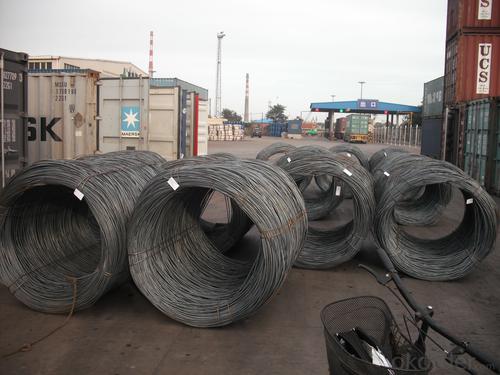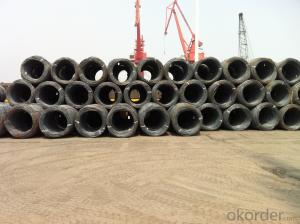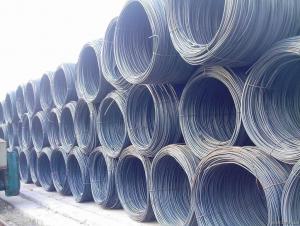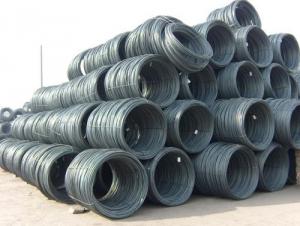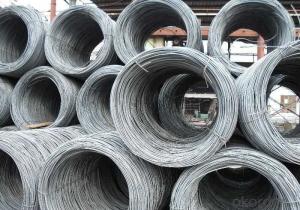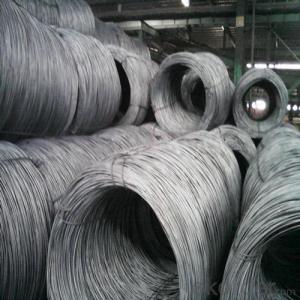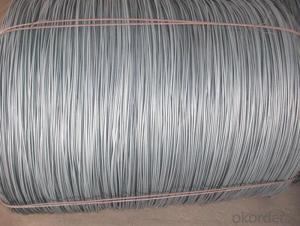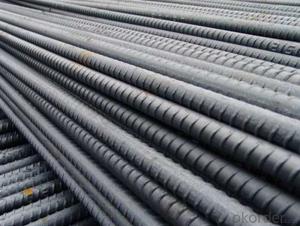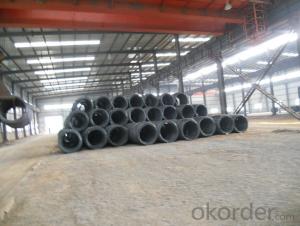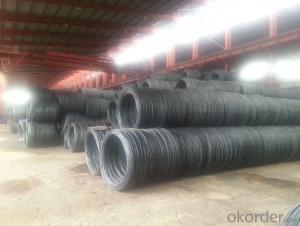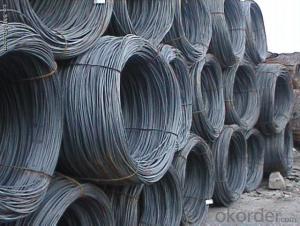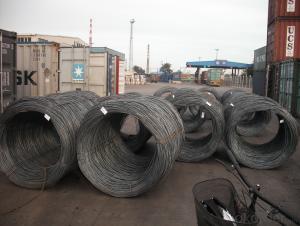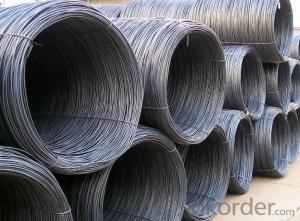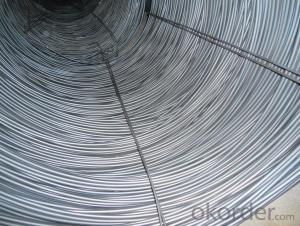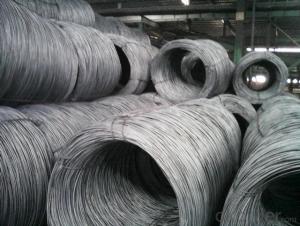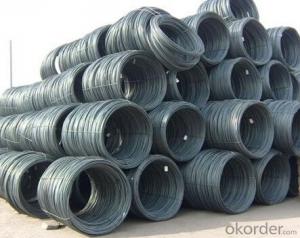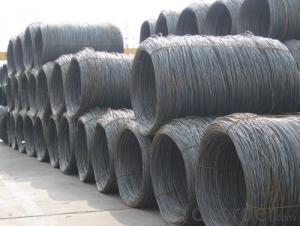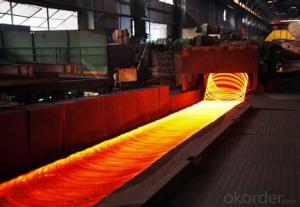Hot Rolled Steel Coil Carbon Wire Rod
- Loading Port:
- China Main Port
- Payment Terms:
- TT or LC
- Min Order Qty:
- -
- Supply Capability:
- -
OKorder Service Pledge
OKorder Financial Service
You Might Also Like
Product Description:
OKorder is offering Wire Rod at great prices with worldwide shipping. Our supplier is a world-class manufacturer of steel, with our products utilized the world over. OKorder annually supplies products to European, North American and Asian markets. We provide quotations within 24 hours of receiving an inquiry and guarantee competitive prices.
Product Applications:
After hot-rolled the products shaped into coil and delivery as finished product, including round, square, rectangular, hexagonal and so on. Since most of the products are round, it is generally called wire rod. Carbon steel wire rod is widely used in construction and manufacturing. Carbon steel wire rod is mainly used for reinforcement of reinforced concrete and welded structure or reprocessed (roberts , nail, etc.) materials, especially used to produce wire drawing, welding electrode, nails, spring, electronic, precise machinery parts and so on.
Product Advantages:
OKorder's Wire Rod are durable, strong, and resist corrosion.
Main Product Features:
· Premium quality
· Prompt delivery & seaworthy packing (30 days after receiving deposit)
· Corrosion resistance
· Can be recycled and reused
· Mill test certification
· Professional Service
· Competitive pricing
Product Specifications:
Steel Grade: Q195/235, SAE1006-1018B Standard: ASTM, GB
Diameter: 5.5mm, 6.5mm, 7mm,8mm,9mm,10mm,12mm,14mm
Type: in coil, coil weight around 2MT Alloy or Not: Alloy
Surface: round, no twisted, light and smooth Chemical Composition: (Please kindly find our chemistry of our material based on Q195、Q235A and Q235B as below for your information)
Packaging & Delivery of Carbon Steel Wire Rod:
Packaging Detail: products are packed in coil, each coil weight around 2 MT, and then shipped by container or bulk vessel
Delivery Detail: within 45 days after received deposit or LC.
Label: to be specified by customer, generally, each bundle has 1-2 labels
Trade terms: FOB, CFR, CIF
Carbon Steel Wire Rod on Port
Carbon Steel Wire Rod in Container
Trademark | Rank | Chemical composition (quality score) % | |||||
C | Si | Mn | S | P | |||
| ≤ |
| ≤ | ≤ | |||
Q195 |
| 0.06-0.12 | 0.30 | 0.25 | 0.050 | 0.045 | |
Trademark | Rank | Pulling Test | |||||
Bend PointΔs/Mpa | Tensile Strength | Elongation Ratioδ5% | |||||
Thickness (Diameter) /MM | Thickness (Diameter) /MM | ||||||
≤16 | 16-40 | ≤16 | 16-40 | ||||
≥ | ≥ | ||||||
Q195 |
| 195 | 185 | 315-390 | 33 | 32 | |
FAQ:
Q1: Why buy Materials & Equipment from OKorder.com?
A1: All products offered byOKorder.com are carefully selected from China's most reliable manufacturing enterprises. Through its ISO certifications, OKorder.com adheres to the highest standards and a commitment to supply chain safety and customer satisfaction.
Q2: How do we guarantee the quality of our products?
A2: We have established an advanced quality management system which conducts strict quality tests at every step, from raw materials to the final product. At the same time, we provide extensive follow-up service assurances as required.
Q3: Can stainless steel rust?
A3: Stainless does not "rust" as you think of regular steel rusting with a red oxide on the surface that flakes off. If you see red rust it is probably due to some iron particles that have contaminated the surface of the stainless steel and it is these iron particles that are rusting. Look at the source of the rusting and see if you can remove it from the surface.
Images:

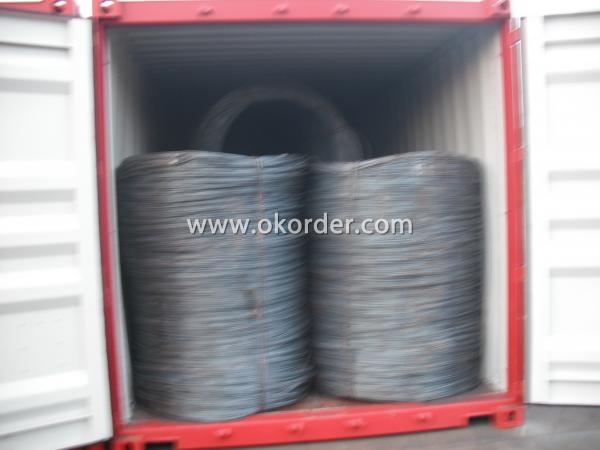
- Q: How is steel wire rod used in the manufacturing of wire for bicycle chains?
- Steel wire rod is used in the manufacturing of wire for bicycle chains as it serves as the raw material for creating the chain links. The wire rod is first drawn through a series of dies to reduce its diameter and increase its strength. This process helps to form the individual chain links with the desired size and shape. The hardened and tempered steel wire rod ensures that the bicycle chain is durable, strong, and capable of withstanding the stress and tension it experiences during use.
- Q: How are steel wire rods used in the production of fencing?
- The production of fencing involves the use of steel wire rods in multiple ways. Initially, these rods are the primary material for manufacturing the wires that compose the fencing structure. They are typically made from high-quality steel, which imparts strength and durability to the fencing. To initiate the production process, the steel wire rods undergo an initial cleaning and coating to prevent rusting and corrosion. Next, they are passed through a series of machines that draw them down to the desired thickness and shape. This drawing process enhances the wire's tensile strength, making it suitable for fencing purposes. Once the wire has been drawn, it undergoes further processing to create various types of fencing products. For instance, some wire rods are twisted or braided together to form chain-link fencing. These interwoven wires create a mesh-like pattern commonly used to secure residential or commercial properties. Typically, the wire rods used for chain-link fencing are galvanized or coated with PVC to increase their longevity and resistance to weathering. In addition to chain-link fencing, steel wire rods are also utilized in the production of welded wire mesh fencing. This type of fencing consists of a grid-like pattern formed by welding intersecting steel wires together. The wire rods used for welded wire mesh fencing are usually galvanized or coated with zinc to prevent rust and corrosion. In summary, steel wire rods are vital in the production of fencing as they provide the raw material necessary to create sturdy, durable, and secure fences. Their versatility allows for the manufacturing of various types of fencing, catering to different needs and requirements in both residential and commercial settings.
- Q: How are steel wire rods used in the production of screws and bolts for construction projects?
- Steel wire rods are an essential component in the production of screws and bolts for construction projects. These wire rods are typically made from carbon steel, which offers excellent strength and durability. To start the manufacturing process, the steel wire rods are first thoroughly cleaned and then heated to high temperatures, which makes them malleable and easier to work with. Once heated, the wire rods are passed through a series of dies, which gradually shape them into the desired form. This shaping process is known as cold heading. During cold heading, the wire rods are transformed into the basic shape of a screw or bolt. The dies used in this process are designed to create the threading and other specific features required for the intended application. This ensures that the finished product has the necessary functionality and can securely fasten different components together. After cold heading, the screws and bolts are usually heat-treated to enhance their mechanical properties. This heat treatment strengthens the steel and improves its resistance to wear, corrosion, and other external forces. Once heat-treated, the screws and bolts are typically coated with a protective layer, such as zinc or other plating, to provide additional durability and prevent rusting. The steel wire rods used in the production of screws and bolts for construction projects provide several advantages. Firstly, steel is a strong and sturdy material, making the resulting products reliable and capable of withstanding heavy loads and vibrations. Additionally, steel is readily available and cost-effective, making it a popular choice for construction fasteners. In conclusion, steel wire rods play a vital role in the production of screws and bolts for construction projects. Through a series of processes like cold heading, heat treatment, and coatings, these wire rods are transformed into high-quality fasteners that provide strength and durability to various construction applications.
- Q: What are the standard lengths available for steel wire rod?
- The standard lengths available for steel wire rod typically range from 2,000 to 2,500 meters.
- Q: How is the quality of steel wire rod measured?
- The quality of steel wire rod is typically measured using various physical and chemical properties such as diameter, tensile strength, ductility, surface finish, and chemical composition. These measurements help ensure that the steel wire rod meets the required standards and specifications for its intended use in various industries.
- Q: What are the growth opportunities in the steel wire rod market?
- The growth opportunities in the steel wire rod market include increased infrastructure development, growing construction industry, and expanding automotive and transportation sectors. Additionally, the rising demand for steel wire rod in electrical and electronics applications, such as power transmission and telecommunications, presents further growth prospects. Furthermore, the trend towards lightweight materials in various industries, such as aerospace, is also expected to drive the demand for steel wire rod.
- Q: How are steel wire rods used in the production of fishing lines?
- To enhance the strength and durability of fishing lines, steel wire rods are employed. These rods act as the backbone of the line, granting it the tensile strength needed to endure the pressure and weight imposed by sizeable fish. Typically crafted from top-notch stainless steel, the steel wire rods employed in fishing lines possess resistance to rust and corrosion. This characteristic is crucial since fishing lines are consistently exposed to water and moisture, which can lead to material deterioration over time. Throughout the manufacturing process, a protective layer, such as nylon or polymer, is applied to the steel wire rods. This coating not only bolsters their performance but also renders them more suitable for fishing purposes. It not only contributes added strength but also enhances the line's flexibility, facilitating easier casting and retrieval. Additionally, the steel wire rods determine the overall diameter and weight of the fishing line. Thicker rods result in a heavier and stronger line, while thinner rods produce a lighter and more sensitive one. This enables anglers to select a fishing line that aligns with their specific requirements and fishing conditions. Moreover, the incorporation of steel wire rods into fishing lines amplifies sensitivity, enabling anglers to detect even the most subtle nibbles or movements by fish. This proves especially advantageous in situations where fish are more cautious and necessitate a delicate approach. In conclusion, steel wire rods play a critical role in the production of fishing lines. They provide the essential strength, durability, and sensitivity required, serving as the foundation of the line to withstand the weight of large fish and resist the detrimental effects of water and corrosion.
- Q: How is steel wire rod used in the production of wire for mattress springs?
- Steel wire rod is a crucial component in the production of wire for mattress springs. It serves as the primary raw material that is used to create the strong and durable wire required for mattress springs. To begin the manufacturing process, steel wire rod is first carefully selected based on its desired properties, such as its tensile strength, flexibility, and resistance to corrosion. The rod is then subjected to a series of processes to transform it into wire suitable for mattress springs. The first step involves heating the steel wire rod and passing it through a series of dies to progressively reduce its diameter. This process, known as wire drawing, helps refine the wire's mechanical properties and ensures uniformity in its thickness. Once the wire has been drawn to the desired diameter, it undergoes further treatment to enhance its strength and resilience. This may involve heat treatment processes like annealing or quenching, which help to improve the wire's flexibility and resistance to fatigue. After the wire has been treated, it is coiled onto spools or reels, ready to be used in the manufacturing of mattress springs. The wire is then fed into specialized spring-making machinery, where it is formed into the required shape and size. These machines use a combination of bending, coiling, and twisting movements to create the intricate spring designs commonly found in mattresses. The high-quality steel wire rod used in the production of wire for mattress springs ensures that the springs are strong, durable, and capable of withstanding the constant pressure and weight applied to them. This results in a mattress that offers excellent support and comfort to the sleeper. In summary, steel wire rod plays a critical role in the production of wire for mattress springs. It undergoes various processes to refine its properties and is then shaped into the required form to create sturdy and resilient springs. This ensures that mattresses made with these springs offer superior support and durability to users.
- Q: How are steel wire rods used in the production of electrical cables for power transmission?
- Steel wire rods are used in the production of electrical cables for power transmission as a reinforcement material. These wire rods provide strength and durability to the cables, allowing them to withstand the high tension and mechanical stress that occurs during power transmission. Additionally, the steel wire rods also enhance the conductivity of the cables, ensuring efficient and reliable energy transfer.
- Q: What are the different surface treatments for steel wire rod?
- Steel wire rods can undergo different surface treatments to enhance their properties and improve performance in various applications. Common surface treatments include: 1. Pickling: Wire rods are immersed in an acid solution to remove oxide scale or rust, resulting in a clean surface, improved corrosion resistance, and preparation for further treatments. 2. Phosphating: Through a chemical conversion process, a thin layer of phosphate coating forms on the wire rod surface. This coating enhances adhesion of subsequent coatings, improves corrosion resistance, and provides a better surface for painting or other finishes. 3. Galvanizing: Wire rods are coated with zinc, which acts as a sacrificial anode and offers excellent corrosion resistance. Galvanized steel wire rods are ideal for outdoor applications or environments with high humidity or exposure to corrosive elements. 4. Electroplating: Metal is deposited onto wire rods using an electric current, allowing for various coatings like nickel, chrome, or copper. These coatings offer improved corrosion resistance, enhanced aesthetics, and increased hardness or wear resistance. 5. Heat treatment: Controlled heating and cooling processes alter the microstructure and mechanical properties of wire rods. This treatment can enhance strength, toughness, hardness, or ductility, depending on the specific heat treatment process applied. 6. Coating: Wire rods can be coated with protective or functional coatings like epoxy, polyethylene, or PVC. These coatings provide additional corrosion resistance, insulation, or lubrication properties and can be applied through processes like hot-dip coating, electrostatic powder coating, or extrusion coating. Each of these surface treatments for steel wire rods offers unique benefits and is chosen based on the specific application's desired properties and requirements.
Send your message to us
Hot Rolled Steel Coil Carbon Wire Rod
- Loading Port:
- China Main Port
- Payment Terms:
- TT or LC
- Min Order Qty:
- -
- Supply Capability:
- -
OKorder Service Pledge
OKorder Financial Service
Similar products
Hot products
Hot Searches
Related keywords



